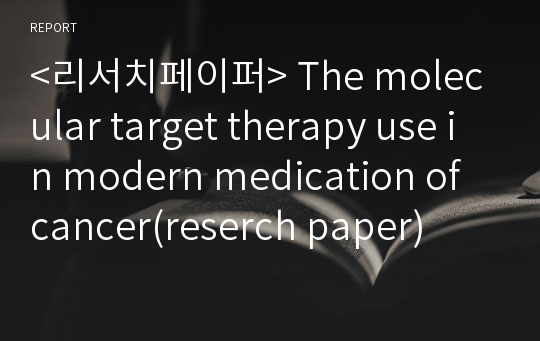<리서치페이퍼> The molecular target therapy use in modern medication of cancer(reserch paper)
*진*
다운로드
장바구니
소개글
의학에관한 리서치 페이퍼미국 ELS 마스터를 졸업하면서 2달동안 쓰고 고치고 쓰고 고치고 하면서
제출 했던 리서치 페이퍼 입니다... A+ 받음
목차
1. Introduction:2. The development of molecular target therapy
3. What is the difference between the molecular target therapy and traditional chemotherapy.
4. Function and effects of molecular target therapy medication
A. Monoclonal Antibodies
B. Small Molecule Inhibitors
5. Moral issue of molecular target therapy
6. Conclusion:
7. Reference:
본문내용
1. Introduction:Molecular target therapy, a new kind of chemotherapy that only attacks the
cancer cell, is a renovation of oncology treatment. Merriam-Webster defined target as “something fired at or marked for attack” and expends the meaning to include “ precisely correct or valid”. Target therapy can decrease the damage to the body and increase the patient’s life quality. Many people expect molecular target therapy so badly. Most of them think it is a panacea that can cure all kind of cancers. No matter this kind of drugs are so expensive and most family can’t afford it. They still spend lots of money for molecular target therapy. Does it really work? Or is it just a dream?
In this paper I want to discuss general molecular target therapy’s history and
some medications. In addition to, I add my own experiences of taking care of the patients who use this kind of chemotherapy before. (Corman, 113)
2. The development of molecular target therapy
In 1997, the FDA reviewed study data for a monoclonal antibody specific for the cell surface anti CD20. This protein had been found to be present on more than 90% of B-cell non-Hodgkin lymphomas. Although present on the majority of mature B-cell, it was not present on stem cells or plasma cells. This made the development of an antibody against CD-20, the drug named Rituximab, an ideal target for patients who have B-cell non-Hodgkin lymphoma. Since 1997, and the approval of Rituximab, new drugs development using increasingly more refined knowledge of cancer molecular biology has progressed at a rate faster than previously seen in oncology. (Corman,113)
The famous molecular target drug is GLIVEC. Which is the biggest advancement in twentieth century. It’s the first genetic target drugs. Two researchers named Peter Nowell, MD, of the university of Pennsylvania school of Medicine and David Hungerford, MD, of the institute for Cancer Research, found a section of DNA missing from chromosome 22. Approximately, 95% of patients with Chronic Myeloid Leukemia (CML) have this alterant chromosome. It’s the first time scientists discovered a genetic abnormality linked to a specific kind of cancer. They were able to identify genetic mutation in patients with chronic myeloid leukaemi in 1960. The discovery meant that for the first time ever, scientists had discovered a genetic abnormality linked to a specific kind of cancer. The discovery of the link between the Ph chromosome and CML set off an explosion of research into the genetic causes of cancer. With the groundbreaking discovery that a single enzyme could cause the development of CML, medical research faced a rare opportunity. Unlike previous efforts, the genetic target was clear, and the development of a drug that could block Bcr-Abl (the gene that might cause CML) could proceed rationally. After two years of painstaking experimentation, the team found the specific inhibitor of Bcr-Abl.
Nowadays, more and more forms of new molecular target therapy are being found such as genetic therapy and hormone therapy, etc. As time goes by, there will be more and more forms of molecular target therapy being used.
참고 자료
Syma Iqbal, and Heinz Josef Lenz, Cancer. California, 2003Pecorino, Lauren, Molecular Biology of Cancer: Mechanisms, Targets, and Therapeutics. US, 2008
Corman Noleman: Understanding Cancer, Maryland, 2006
Shu-shin chi: Treatment of chemotherapy, Taiwan, 2005
Arlene L.P and Suzanne E .T: Luckmann`s core principles and practice of medical-surgical nursing, Taipei, 2002
Gillatte Mary Magee: A Chemotherapy Handbook, Pennsylvania, 2007
Julie K. Silver: After Cancer Treatment, Maryland, 2006
The Journal of Laboratory and Clinical Medicine, Mar 2006. Molecular targeted therapy: A strategy of disillusions or optimism?. 4 Dec 2008
<http://www.journals.elsevierhealth.com/periodicals/ymlc/article/PIIS0022214305003860/abstract>
Nation institute for medical research. 2003. Glivec, CML, Abl and Targeted molecular Therapy For Cancers. 7 Dec 2008
<http://www.nimr.mrc.ac.uk/millhillessays/2003/glivec/>
Medical News Today, 2005. The History of Glivec. 23 Dec 2008
<http://www.medicalnewstoday.com/articles/35394.php>
Chemotherapy.com, 2008. Treating Cancer With Chemotherapy. 23 Dec 2008
<http://www.chemotherapy.com/treating_with_chemo/treating_with_chemo.jsp>
We Are Macmillan Cancer Support, 2008. Imatinib. 23 Dec 2008 <http://www.cancerbackup.org.uk/Treatments/Biologicaltherapies/Cancergrowthinhibitors/Imatinib >





























